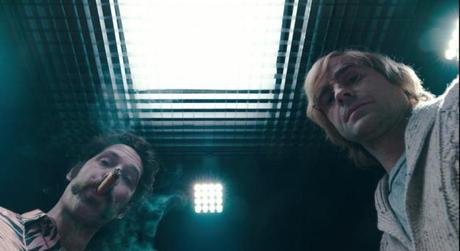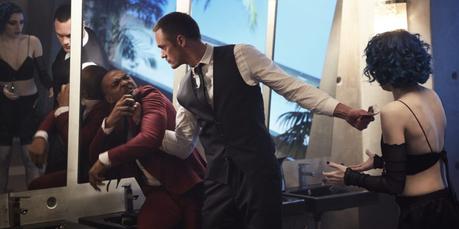The story behind the making of so many classic movies is one of overcoming overwhelming odds. It's about unknown and unproven talent refusing to give up and finally finding someone willing to take a chance on them. It's the story of being a visionary in a reactionary business or being more interested in actually making a movie in an industry more concerned with theme park attractions and ancillary profits. Or sometimes it just comes down to somehow finding your way to creating a transcendent work of cinema out of an absolutely chaotic production.
Duncan Jones' Mute ...is not one of those stories.
Well, actually, it kind of is. The tale of woe behind the film is one of perseverance, heartbreak, and redemption. The actual film itself, though, is far from a classic. In fact, it's just not very good, yet another example of what happens when Netflix sets out to release more Original movies in a single year than every major studio will combined. See, sometimes Hollywood is right. Not every film trapped in the bottomless hole of development hell needs or deserves to be rescued. But Netflix has a quota to hit and increasingly lax standards to uphold. So, here we are with Mute, a movie which mostly gets by on being vaguely watchable and earns points for at least being more competently put together than The Cloverfield Paradox. Duncan Jones is capable of better than this, though.
A spiritual sequel to Jones' first feature Moon, Mute takes place in 2050 Berlin, which looks like an updated, more multicultural, slightly brighter rendering of Blade Runner's future Los Angeles. The design work is eye-catching, but also a bit familiar in a sci-fi landscape freshly flooded with Blade Runner imitators like Ghost in the Shell, Altered Carbon, and, of course, Blade Runner: 2049. Jones picked Berlin because he grew up there in the 70s and because he felt it represented a modern melting pot which could be projected into a future cityscape where all manner of people have to simply learn how to get along. The latter intention shows itself in the diverse casting (e.g., Americans, Brits, Germans, Africans, Asians) but fails to actually pay off thematically. There's an interesting story to be told about a future city overflowing with people of so many different ethnicities and worldviews; Mute isn't that movie, though.
The multiculturalism is mere background noise to the main plot, which revolves around a mute bartender's (Alexander Skarsgard's Leo) search of the Berlin underworld for his suddenly disappeared girlfriend Naadirah (Seyneb Saleh). This is a perfectly reliable set-up for various run-ins with pimps, sex workers, corrupt doctors, nightclub owners, and...Dominic Monaghan in full kabuki makeup, for some reason. Yet Mute can't quite follow through on this or even settle on a fully coherent narrative.

Duncan Jones gave himself a huge challenge by making the lead character mute, but even after nearly two decades of fine-tuning the script his solution, apparently, is to take this movie which should be about Leo's ongoing struggles and eye-opening experiences and make it just as equally about the plight of two smart-ass doctors working as torturers-for-hire for some seriously seedy people. This means every time the film feels like it's getting somewhere interesting with Leo we have to sit through another seemingly pointless sequence of Paul Rudd and Justin Theroux doing their best impressions of noticeably more sinister versions of M*A*S*H* 's Hawkeye and Trapper.
The casting allows both to play against type, which isn't always a good thing. Paul Rudd is wholly unconvincing as the hotheaded heavy, and Theroux's performance feels oddly upstaged by his own wig, although there is a creepiness underneath his subdued line readings which pays dividends in the second half of the film.

The problem is the two parts of the film feel too disconnected. Leo and the doctors (sidebar: good name for a band?) interact more like passing ships in the night than truly interconnected characters in the same movie. When they finally come together, in the end, it happens in the most predictable fashion possible, meaning the payoff to Jones' choice to make this a split-narrative frustrates more than it satisfies.
However, you can understand why Jones keeps cutting to Rudd and Theroux. It's mostly because he has no idea what to do with Leo, who is portrayed here with an almost Marty McFly-esque anger trigger where whenever someone says something bad about Naadirah he launches into extreme, violent rage. So, really, a lot of the movie is just Leo randomly attacking people and then having a mid-movie freakout where he wonders if perhaps, given his rage, he killed Naadirah and blacked it out, which is a story idea that disappears as quickly as it arrives.

Skarsgard, always an enjoyable, but a limited actor, deploys various pained facial expressions to communicate Leo's steadfast determination and occasional frustration. His constant-hunched stance makes his more sure-footed physical assaults on those who dare impugn his girlfriend's name extra effective. Thus, Skarsgard's physicality lends Leo an intriguing quality, but even by the end of the film he's just not much of a character.
Such a shame.
Jones devoted 16 years of his life to getting this movie made, reduced to exploring the possibility of making it as a graphic novel until Netflix came along. In the time since he finished Mute's first draft in 2003, he directed three other movies ( Moon, Source Code, Warcraft), became a husband, supported his wife through her fight with breast cancer, supported his famous father (David Bowie) and his ultimate losing battle to cancer, lost the woman who raised him, and became a father to two young children. As such, Mute morphed over the years into an incredibly personal project for Jones. It's set in the town he grew up in. The missing person plot now dovetails into ruminations on fatherhood and loss. The final frame is used to dedicate the film to the memory of Jones' dead dad and the woman he considered to be his mother.
Thus, one can't really fault Jones' passion, and unlike a theatrical experience, all you're giving up by watching Mute on Netflix is a couple hours of your life. There are certainly far worse Netflix Originals begging for your time. However, a new, original sci-fi movie from the man who directed Moon and Source Code sounds like such a winning formula. That's what makes Mute 's failure all the more disappointing.
THE BOTTOM LINEAnother disappointing Netflix Original which tries to be two movies at once even though neither one of those movies is all that interesting. The derivative, but intriguing visuals at least adds some appeal, and Jones tosses in several camera movements which are objectively amazing. Too bad more effort couldn't have been spent on getting the story and characters right.
CRITICAL CONSENSUS RIGHT NOW RANDOM PARTING THOUGHTS- One example of how Mute might have been improved by traditional studio notes: Leo was raised Amish, which is reflected in the conservative clothes he wears and his ongoing decision against having surgery to repair the vocal cords that were damaged in a childhood accident. But other than the built-in "why he can't talk even though future science could maybe heal him" explanation this part of his background is largely pointless. The notion of him actively choosing to live a certain way or the idea of him maybe being constitutionally unprepared for what he sees in his journey never truly pays off. A studio note would have forced Jones to rethink and re-justify that character decision or remove it entirely. Instead, it remains intact and adds nothing to the movie other than the peculiar image of a man in a tweed suit patrolling the Berlin nightlife.
- Positive note pointed out to me on Twitter: Clint Mansell's musical score for this film is fantastic.
- Mute was actually shot in Berlin, specifically at the ICC, Brandenburg Gate, and Babelsberg Studio, which is where Metropolis and Nosferatu were filmed.
- SPOILER ALERT: Jones almost literally fridges Naadirah in the end. How did that still seem like a good idea to him even after 16 years of developing the script?

